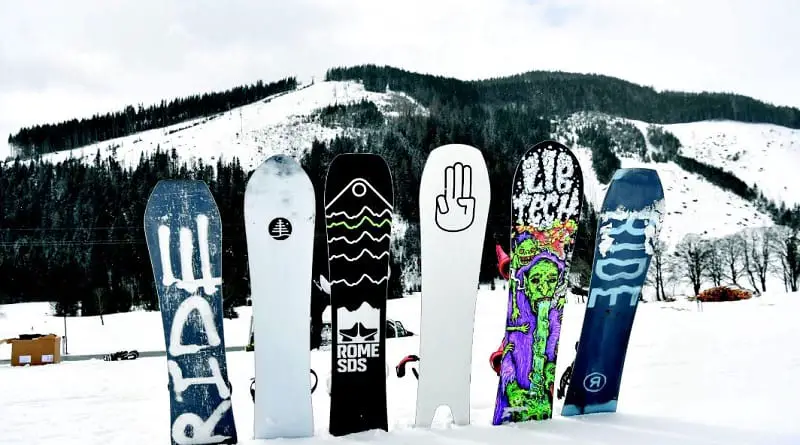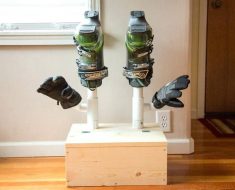Table of Contents
Whether you like the rugged backcountry terrains or floating through groomed powder, it takes the right snowboard for you to do it right and with much enjoyment. If you are determined, it may take you a short time to learn snowboarding. To avoid purchasing a snowboard with each change of level, the need to get a snowboard that accommodates your progress is understandable.
First things first, let’s look at the different types of snowboards.
Types of snowboards based on their shape

Every aspect of a snowboard has a function attached to its performance. While you are bound to find a variety of shapes and sizes out there, your choice will depend greatly on the condition of the grounds on which you will snowboard.
Based on their shapes, here are the different types of snowboards.
Directional shape
A directional board, just as the name suggests favors movement in one direction. It is designed with a long pointed nose and shorter blunted tail which favors a backward stance and forward movement. This board is suitable for speed rides and will make an excellent choice for free riders and all-mountain riders since typically these styles are focused on forwarding movement.
They are an asset on powder. Their shape lets the tail sink gently in powder while the nose floats on the snow allowing for a smooth plow through powder.
Directional twin shape
While the directional twin shape snowboard may easily pass off as a true twin, its nose and tail differs in flex, size, and shape from that of a true twin. This board can either be designed with a stiff flex, a nose that is raised a little more than the tail, or a different camber profile towards the nose from that of the tail. These will determine its most suitable application. However, directional twin boards are best suited for those who fancy all mountain and freestyle rides packed with tricks and a lot of play. It could be used as a twin board if it will have been designed with a setback stance in mind.
True twin
The true twin, unlike the directional or directional twin shapes, is designed with equal flex and dimensions for both its nose and tail. Secondly, its bindings are located same distances from the center and the ends of the board which means that this board rides well in both the forward and backward direction. This shape is pretty versatile since you can comfortably ride switch on it without feeling the difference. Because riding switch, performing tricks, and lots of play on literally all trails are typical of freestyle and all-mountain riding, this board is popular among freestylers and all-mountain riders.
Asymmetrical
With the realization that the human body isn’t actually symmetrical forward and backward and they are left to right, the asymmetrical snowboard has become a very popular option for snowboarders. This is because it enhances the turning performance with specific designs for the toes and the heels. Asymmetrical snowboards are designed with asymmetrical side cuts, flex, and cores.
Essentially, these boards have deeper and shorter side cuts as well as a softer flex on the heel side compared to the toe side. This makes it easy to maneuver a quick turn on this side without losing balance. Technically, it is not easy to maneuver such curves on the other boards given the natural structure of the human body.
Types of snowboards based on riding style

After making a decision that snowboarding is the activity you want to engage in, the next important decision is deciding your style. For the pro, this should be easy because they are already familiar with the terrain and condition they have been working so hard to master. Beginners, on the other hand, may take a little longer settling on a specific terrain which is okay. Apart from having an idea of the style you intend to master in snowboarding, your height, weight, and to some extent preference, should also guide you into choosing the right type of snowboard.
All-mountain
For beginners who are still mastering the art of snowboarding, this is the best place to start. All-mountain enthusiasts and other boarders in general also prefer this type of snowboard. The all-mountain snowboard will perform well for any type of terrain. Whether you love the backcountry adventures, cruising through the park pipes, or leisurely riding the groomed trails, there is no limit to what this board can do.
This board features a directional shape and is designed with a short and narrow tail compared to its nose. Again, it comes with a deeper sidecut to make it easy to engage curves.
Freestyle
For the park rider who loves tricks and spins while riding, the freestyle snowboard makes a good option for the park and halfpipe riders. This snowboard can either be twin or directional twin shape but with a center stance which allows the rider to move backward or forward easily. It is light and short to accommodate all the action that riders take it through. However, while it will offer remarkable performance during tricks, this snowboard is not the best for navigating curves because it lacks the asymmetry needed to maintain balance and control during turns.
Freeride
Freeride boards are quite basically designed for backcountry’s adventure thrills. They perform excellently in the ungroomed, backcountry terrains which only the daredevils will venture into. These snowboards are directional in shape with a backward stance which makes them ideal for downhill rides. For this reason, they feature a nose that is slightly raised compared to the tail. They are a good option for those looking for a board for speed with a stiff flex and have been designed with a deeper sidecut useful for maneuvering sharp turns.
Powder
Powder boards are intended for floating on deep powder. They are designed with a broader nose and base and are taller with a rocker profile making them better floaters on snow.
Other elements of a snowboard

Snowboard profile
The snowboard profile refers to the shape of your board at the bottom when placed flat on the ground. There are three main types of profiles including camber, rocker, and flat. Others like the modified camber which is a hybrid of rocker and camber came out of the original three.
- Camber. Also known as the traditional camber, the camber profile curves upwards at the center to enhance response and stability in a snowboard. This favors groomed park rides which feature lots of twists and turns. Today cambers vary in the way the edge and the center point lift off the snow trail with some higher than others.
- Rocker. Rocker is also known as reverse camber. It resembles a camber that has been turned upside down. With its tip and tail curving slightly off the snow surface. It is a good entry level snowboard profile as it is great at floating on powder and lets riders negotiate turns with much ease. This gives beginners the confidence needed to move to the next level of their learning curve.
- Flat. Just as the name suggests, a flat profile is literally flat at the bottom. A flat profile offers a good grip at its edge and is also great at navigating snow trails.
- Camber/rocker. This is a hybrid of the chamber and the rocker profiles. This profile brings together the advantages of both rocker and camber profiles into one board. It gives its riders a good edge grip while still floating excellently and allowing for easy turning.
- Flat rocker. The difference between the flat rocker and flat profiles is that while both have completely flat center sections, the flat rocker is designed with tips and tails that curve slightly off the ground. This makes them float remarkably while still providing a good edge grip, especially during turns.
Snowboard length
Ideally, the length of snowboard should be determined by your weight and height. For instance, someone weighing 150 lb would feel awkward riding a 130 cm board. Secondly, speed boards tend to be longer than boards designed for park riding.
Snowboard width
The snowboard width has three different measurements
- The width of the nose
- The width of the tail
- The waist width
Choosing the right size snowboard width is very critical to performance. A wide width, even though it enhances stability, will affect how well you will maneuver on the snow trail. A narrow width, on the other hand, may be easier to maneuver but harder to control as it will cause a toe drag.
The right width of your snowboard is determined by the size of your feet and boots. In essence, your boots should match the waist width of the snowboard, going over by no more than ½ an inch on either edge. For people with wide feet, selecting a wide snowboard will be in order.
Again, women in general, are more comfortable with narrow soft flexed boards since their feet run narrower than those of men.
Sidecut radius
The radius of two arcs joined together into a circle at the center section of a snowboard is known as the sidecut radius. The sidecut radius is significant in determining the turns that a snowboard will make. Boards with narrow waist widths tend to have a short sidecut radius which is good for making sharp turns. On the other hand, a wider waist width means a longer sidecut radius hence bigger smoother turns. Longer sidecuts will also deliver better stability, particularly during high speed.
Effective edge
The distance between the widest point of the nose of a snowboard to the widest point of its tail is known as the effective edge. This edge, made of metal, is usually what digs into snow as you ride on your board and is functional for yielding control. The effective edge does not reach the furthest end of the tip and tail and is therefore typically shorter than the overall length of the snowboard. As is the rule of thumb for snowboard elements, longer means stability at high speeds and shorter means easy turns and maneuvers.
Conclusion
The different types of snowboards can be differentiated by several factors as we have already seen. It is important that when selecting a snowboard, you consider all these factors with the help of a professional. This way, you will be getting a board not just for your immediate needs but for use for a long time to come.







